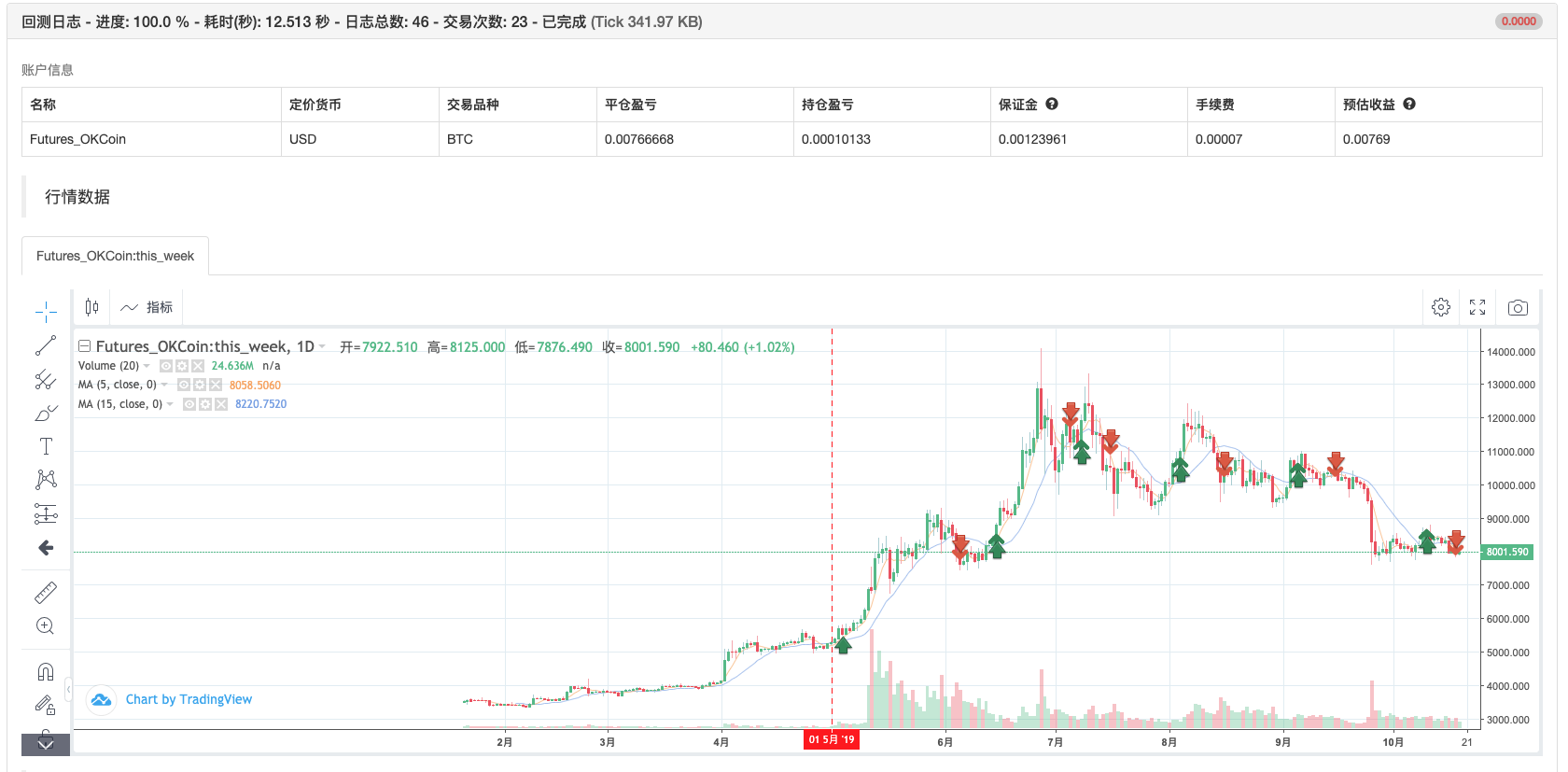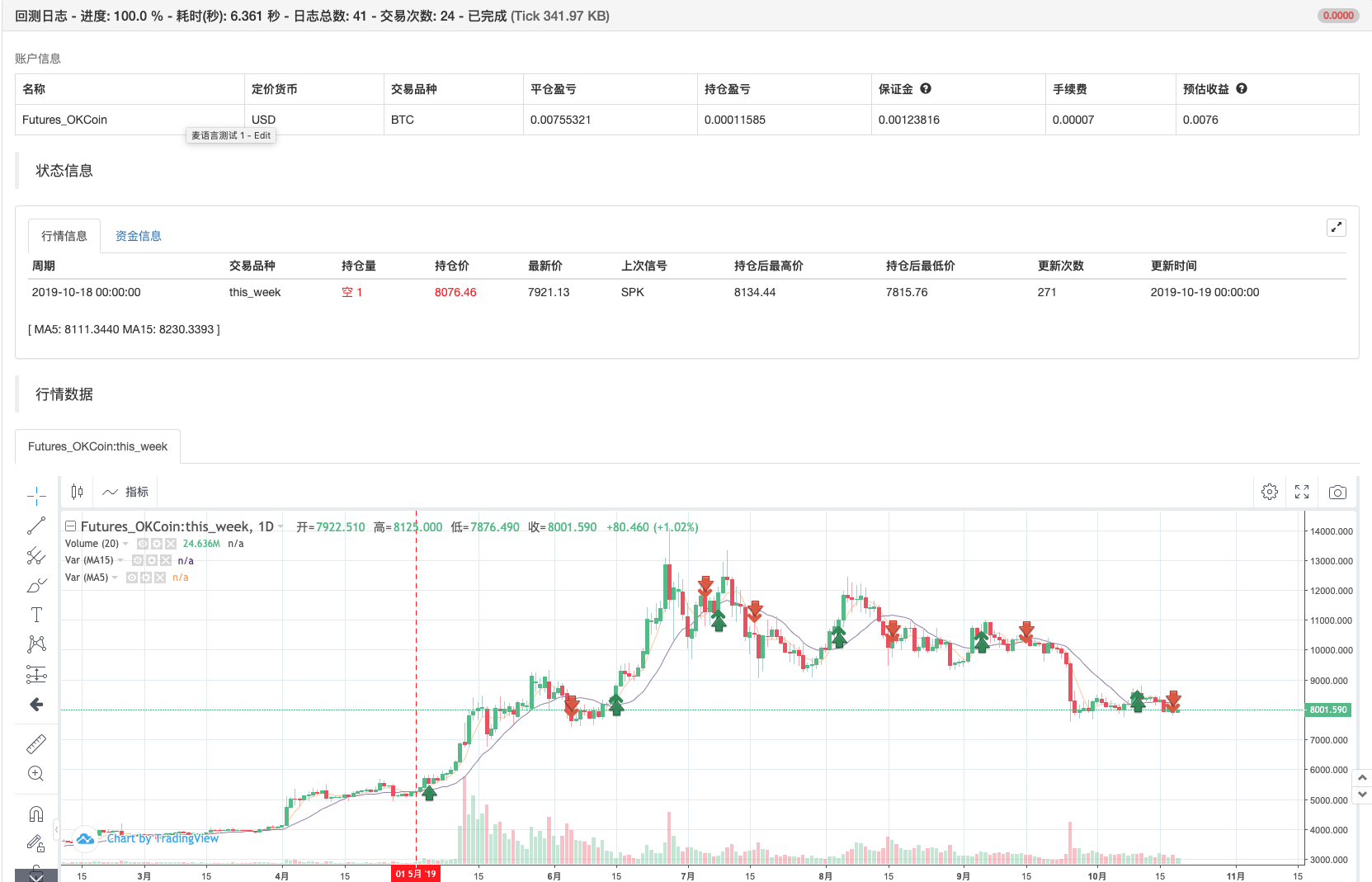The hand teaches you how to write a strategy -- to translate a strategy into my language.
Author: Inventors quantify - small dreams, Created: 2019-10-21 14:59:12, Updated: 2023-10-17 21:22:56
Hands that teach you how to write strategies and transplant a my language strategy
Recently, while talking with a friend about strategies, I learned that there are many problems with the flexibility of using my language writing strategies. In many cases, it is necessary to use the standard K-line cycle provided by the non-system, for example, the most commonly requested is the use of 4 hours of K-line.LinksHowever, in my language strategy, this problem is due to my language's highly encapsulated nature, which does not allow for flexible self-processing of data.
For trend strategy porting is very simple, we can use a sample code to fill in the data computation part of the code that drives the strategy, filling in the conditions for triggering the trade signal.
Reusable example code:
For example, the strategy used for OKEX futures.
// 全局变量
var IDLE = 0
var LONG = 1
var SHORT = 2
var OPENLONG = 3
var OPENSHORT = 4
var COVERLONG = 5
var COVERSHORT = 6
var BREAK = 9
var SHOCK = 10
var _State = IDLE
var Amount = 0 // 记录持仓数量
var TradeInterval = 500 // 轮询间隔
var PriceTick = 1 // 价格一跳
var Symbol = "this_week"
function OnTick(){
// 驱动策略的行情处理部分
// 待填充...
// 交易信号触发处理部分
// 待填充...
// 执行交易逻辑
var pos = null
var price = null
var currBar = records[records.length - 1]
if(_State == OPENLONG){
pos = GetPosition(PD_LONG)
// 判断是不是 满足状态,如果满足 修改状态
if(pos[1] >= Amount){
_State = LONG
Amount = pos[1] // 更新实际量
return
}
price = currBar.Close - (currBar.Close % PriceTick) + PriceTick * 2
Trade(OPENLONG, price, Amount - pos[1], pos, PriceTick) // (Type, Price, Amount, CurrPos, PriceTick)
}
if(_State == OPENSHORT){
pos = GetPosition(PD_SHORT)
if(pos[1] >= Amount){
_State = SHORT
Amount = pos[1] // 更新实际量
return
}
price = currBar.Close - (currBar.Close % PriceTick) - PriceTick * 2
Trade(OPENSHORT, price, Amount - pos[1], pos, PriceTick)
}
if(_State == COVERLONG){
pos = GetPosition(PD_LONG)
if(pos[1] == 0){
_State = IDLE
return
}
price = currBar.Close - (currBar.Close % PriceTick) - PriceTick * 2
Trade(COVERLONG, price, pos[1], pos, PriceTick)
}
if(_State == COVERSHORT){
pos = GetPosition(PD_SHORT)
if(pos[1] == 0){
_State = IDLE
return
}
price = currBar.Close - (currBar.Close % PriceTick) + PriceTick * 2
Trade(COVERSHORT, price, pos[1], pos, PriceTick)
}
}
// 交易逻辑部分
function GetPosition(posType) {
var positions = _C(exchange.GetPosition)
var count = 0
for(var j = 0; j < positions.length; j++){
if(positions[j].ContractType == Symbol){
count++
}
}
if(count > 1){
throw "positions error:" + JSON.stringify(positions)
}
for (var i = 0; i < positions.length; i++) {
if (positions[i].ContractType == Symbol && positions[i].Type === posType) {
return [positions[i].Price, positions[i].Amount];
}
}
Sleep(TradeInterval);
return [0, 0];
}
function CancelPendingOrders() {
while (true) {
var orders = _C(exchange.GetOrders)
for (var i = 0; i < orders.length; i++) {
exchange.CancelOrder(orders[i].Id);
Sleep(TradeInterval);
}
if (orders.length === 0) {
break;
}
}
}
function Trade(Type, Price, Amount, CurrPos, OnePriceTick){ // 处理交易
if(Type == OPENLONG || Type == OPENSHORT){ // 处理开仓
exchange.SetDirection(Type == OPENLONG ? "buy" : "sell")
var pfnOpen = Type == OPENLONG ? exchange.Buy : exchange.Sell
var idOpen = pfnOpen(Price, Amount, CurrPos, OnePriceTick, Type)
Sleep(TradeInterval)
if(idOpen) {
exchange.CancelOrder(idOpen)
} else {
CancelPendingOrders()
}
} else if(Type == COVERLONG || Type == COVERSHORT){ // 处理平仓
exchange.SetDirection(Type == COVERLONG ? "closebuy" : "closesell")
var pfnCover = Type == COVERLONG ? exchange.Sell : exchange.Buy
var idCover = pfnCover(Price, Amount, CurrPos, OnePriceTick, Type)
Sleep(TradeInterval)
if(idCover){
exchange.CancelOrder(idCover)
} else {
CancelPendingOrders()
}
} else {
throw "Type error:" + Type
}
}
function main() {
// 设置合约
exchange.SetContractType(Symbol)
while(1){
OnTick()
Sleep(1000)
}
}
Example: Transplantation of the double equation strategy
I'm not going to say anything about it.
This is the code of the Ma language strategy:
MA5^^MA(C,5);
MA15^^MA(C,15);
CROSSUP(MA5,MA15),BPK;
CROSSDOWN(MA5,MA15),SPK;
Porting to JavaScript policy
The first step is to fill in the Market Acquisition, Indicator Calculation section of the reusable sample code:
// 驱动策略的行情处理部分
var records = _C(exchange.GetRecords)
if (records.length < 15) {
return
}
var ma5 = TA.MA(records, 5)
var ma15 = TA.MA(records, 15)
var ma5_pre = ma5[ma5.length - 3]
var ma15_pre = ma15[ma15.length - 3]
var ma5_curr = ma5[ma5.length - 2]
var ma15_curr = ma15[ma15.length - 2]
So you can see that the two-square strategy is very simple, just get the data from the k-line first.records, and then useTA函数库The uniform line functionTA.MACalculate the 5-day mean line, 15-day mean line (as you can see on the retest interface, the K-line cycle is set to the daily K-line, soTA.MA(records, 5)This is the average of five days.TA.MA(records, 15)This is the 15th day of the lunar calendar.
And then you getma5The second decimal point of the indicator datama5_curr(indicator value), the third decimal pointma5_pre(Indicator value)ma15The indicator data is symmetrical. The indicator data can then be used to judge the gold forks, as shown below: If this is the case, then it is a definite golden fork death fork.
If this is the case, then it is a definite golden fork death fork.
If you have a message that you want to send to the other person, then the part of the message that you want to send to the other person is:
if(_State == IDLE && ma5_pre < ma15_pre && ma5_curr > ma15_curr){
_State = OPENLONG
Amount = 1
}
if(_State == IDLE && ma5_pre > ma15_pre && ma5_curr < ma15_curr){
_State = OPENSHORT
Amount = 1
}
if(_State == LONG && ma5_pre > ma15_pre && ma5_curr < ma15_curr){
_State = COVERLONG
Amount = 1
}
if(_State == SHORT && ma5_pre < ma15_pre && ma5_curr > ma15_curr){
_State = COVERSHORT
Amount = 1
}
The transplant is OK, so you can go back and test:
Re-testing the JavaScript policy
Re-test the configuration:
回测结果:

My language retest
The results of the retest are basically the same, so this is possible if you want to continue adding interactive features to the policy, adding data processing (e.g. K-line synthesis), adding custom graphic displays.
Students who are interested can try it.
- New Feature of FMZ Quant: Use _Serve Function to Create HTTP Services Easily
- Inventors quantify new functionality: Easily create HTTP services using the _Serve function
- FMZ Quant Trading Platform Custom Protocol Access Guide
- FMZ Funding Rate Acquisition and Monitoring Strategy
- FMZ funding rate acquisition and monitoring strategies
- A Strategy Template Allows You to Use WebSocket Market Seamlessly
- A policy template that allows you to use WebSocket seamlessly
- Inventors Quantified Exchange Platforms General Protocol Access Guide
- How to Build a Universal Multi-Currency Trading Strategy Quickly after FMZ Upgrade
- How to quickly build a universal multi-currency trading strategy after FMZ upgrade
- DCA Trading: A Widely Used Quantitative Strategy
- Modified Deribit futures API to accommodate options quantitative trading
- Use research environments to analyze the impact of triangular hedging details and royalty on hedgeable price differentials
- Introducing FMZ Quant data science research environment
The Little PrinceLearning